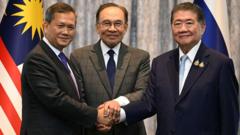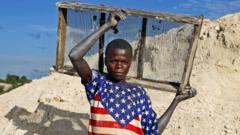China's birthrate crisis is prompting the government to act with a new program that offers parents up to $1,500 per child annually, signaling a desperate move amid ongoing demographic challenges.
China Introduces Subsidy Program to Encourage Birth Rates

China Introduces Subsidy Program to Encourage Birth Rates
In an effort to combat declining birth rates, China is offering financial incentives to parents for each child under three.
China is introducing a nationwide subsidy to boost its sagging birth rates, with the government offering parents a financial hand of 3,600 yuan (approximately $500) each year for children aged three and under. The initiative comes as the falling birth rate remains a pressing concern, even in light of the abolition of the one-child policy nearly a decade ago.
The newly announced plan, which started retroactively from January 2023, aims to support around 20 million families in managing the costs associated with child-rearing. Parents could see a total subsidy of up to 10,800 yuan per child, with those having children born from 2022 to 2024 eligible for partial benefits. Various provinces in China have tested similar incentive schemes, responding to the imminent demographic crisis facing the country.
For instance, in March, the city of Hohhot introduced a substantial payout of up to 100,000 yuan for families having their third child, while Shenyang is providing a monthly allowance of 500 yuan for families with children under three. Additionally, the government has expressed intentions to implement free preschool education, further encouraging families to have more children.
According to the YuWa Population Research Institute, China ranks among the most expensive countries in the world to raise children, with average costs to the age of 17 reaching $75,700. This economic pressure, combined with a rapidly aging population, has fueled concerns over future societal stability.
Official records indicate that the declining birth rate trend shows no sign of reversal, with a reported 9.54 million babies born in China in 2024, marking a marginal uptick from the previous year, but overall population decline continues. As policymakers grapple with these challenges, the future of China’s demographic landscape remains uncertain.
The newly announced plan, which started retroactively from January 2023, aims to support around 20 million families in managing the costs associated with child-rearing. Parents could see a total subsidy of up to 10,800 yuan per child, with those having children born from 2022 to 2024 eligible for partial benefits. Various provinces in China have tested similar incentive schemes, responding to the imminent demographic crisis facing the country.
For instance, in March, the city of Hohhot introduced a substantial payout of up to 100,000 yuan for families having their third child, while Shenyang is providing a monthly allowance of 500 yuan for families with children under three. Additionally, the government has expressed intentions to implement free preschool education, further encouraging families to have more children.
According to the YuWa Population Research Institute, China ranks among the most expensive countries in the world to raise children, with average costs to the age of 17 reaching $75,700. This economic pressure, combined with a rapidly aging population, has fueled concerns over future societal stability.
Official records indicate that the declining birth rate trend shows no sign of reversal, with a reported 9.54 million babies born in China in 2024, marking a marginal uptick from the previous year, but overall population decline continues. As policymakers grapple with these challenges, the future of China’s demographic landscape remains uncertain.




















